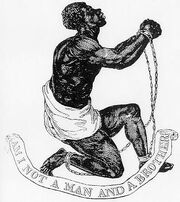Before Mary Wollstonecraft Shelley published Frankenstein in 1818, the abolition of the slave trade was one of the biggest socio-political issues of the day. Shelley was greatly influenced by many factors, including the scientific evidence brought forth by modern sciences to either support or abolish slavery, the influence of her parents and their views on slavery, and the literature read by Percy and herself in the months before and during the writing of Frankenstein. Family involvement not only shaped the way that Mary viewed the world, but also the way that she expressed her ideas about the treatment of mankind through the characterization Frankenstein's Creature.
Theories of the Period[]

Credit: wikipedia.org
Before the introduction of scientific evidence, people in European society’s beliefs about blacks were influenced by the exotic and fantastic literature of people such as Richard Hakluyt and Samuel Purchas, who sought to justify the conquest of a "lesser" race (Malchow 93). By the dawn of the 17th century, two ideas were in circulation about the origin of the human species. Polygenism held that the different races of people had developed separately, and that the “missing link” between humans and primates rested in the Negro slave (Mellor 3). A different theory, Monogenism, drew from Biblical sources, stating that all races are descended from Adam and Eve and that differences in color of skin and body shape were the result of different environments (Mellor 3). In 1775, Johann Friedrich Blumenbach’s doctoral disseration identified four different races of man: the Caucasian, the Mongolian, the American, and the Ethiopian, with the Malay being added some time later.These classifications were based on four characteristics: skin color, hair, the shape of the skull, and body form (Mellor 3-4). The French Revolution also influenced people’s views by giving the middle and upper classes a healthy fear of violent revolution by the oppressed peoples (Malchow 94).
Godwin and Wollstonecraft's Influential Views[]
Mary Wollstonecraft Shelley was greatly influenced by the writings of her father, William Godwin. Free blacks were not unknown to Shelley or her family, seeing that Godwin published a tale called “Washing the Blackamoor White” in his work Fables Ancient and Modern (1807). This included an aside that stated “The other day I stopped involuntary to look at a negro I passed on the street… there was nothing brutal or insulting or coarse in his manner”. Godwin exposed his daughter to these issues through his direct involvement with abolitionist causes. Godwin himself covered the debates on the slave trade for New Annual Register from 1780-1790, and was present in 1791 when William Wilberforce’s motion to abolish the slave trade was defeated (Malchow 98). He even represented beliefs in racial equality when in his novel St. Leon (1799) he portrayed a black turnkey with “sound understanding and an excellent heart” (Malchow 98). These writings, both historical and fiction, help to convey Godwin’s beliefs that guided and shaped the way that Mary Shelley perceived oppressed and enslaved people.
Shelley’s mother, Mary Wollstonecraft, also helped to influence Shelley’s beliefs even though she died a few days after giving birth to her. Wollstonecraft became one of the leading female voices of radical causes through her works, including A Vindication of the Rights of Woman. There she writes “Is one half of the human species, like the poor African slaves, to be subject to prejudices that brutalise them...only to sweeten the cup of men.” Wollstonecraft refers to the sugar cane reaped by enslaved Africans and shipped to Europe from the Americas and the West Indies (Crawford 1). Wollstonecraft often related the oppression of slaves by men to the oppression of women by men. These views directly translate into all of her works, which were read by Shelley (Malchow 98).
In 1814, Mary Shelley kept a record of the literature that she and her husband, Percy, read. They read the first two volumes of "Mungo Park’s relation of the interior of western Africa” (Malchow 99), followed by the third volume in 1816. From 1814-15 they also read a history of the British West Indies by Bryan Edwards, which was so enthralling to Mary that she was unable to put it down day and night (Malchow 100). During that time she associated herself with many people, one of which was William Lawrence. Lawrence probably met Percy Shelley in 1811 while attending a lecture on anatomy at St. Bartholomew’s Hospital, and he was eventually introduced to Mary (Mellor 9). Lawrence was a firm believer in Blumenbach’s beliefs about the seperation of races and the distinction between those races (Mellor 7). Lawrence became the basis for Professor Waldman in Frankenstein, one of the teachers that influences Victor’s research into the creation of his famous monster. Lawrence personally believed that chemistry was the highest form of science, a science that Victor closely studies and uses in his research (Mellor 7).
Works Cited[]
Crawford, Elizabeth. "Women: From Abolition to the Vote." BBC News. BBC, 20 June 2011. Web. 27 Sept. 2013.
Malchow, H. L. "Frankenstein's Monster and Images of Race in Nineteenth-Century Britain". Past & Present, No. 139 (May, 1993): 90-130. Oxford University Press.
Mellor, Anne K. "Frankenstein, Racial Science, And The Yellow Peril." Nineteenth-Century Contexts 23.1 (2001): 1-28. Historical Abstracts.
